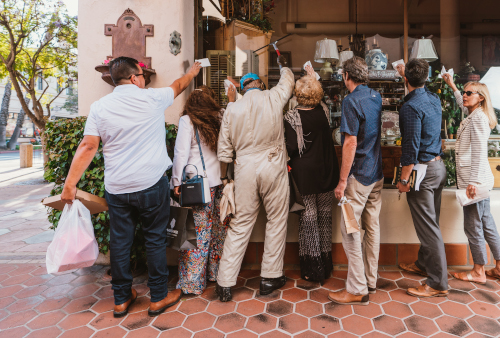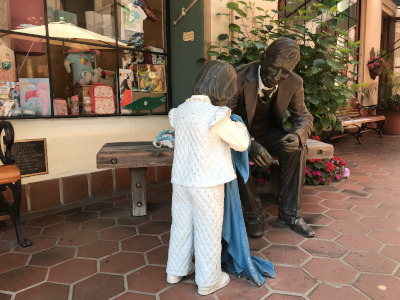Imagine turning back the clock some 90 years when the La Arcada was built. The Spanish Revival style shopping and dining destination was designed and built by famed architect Myron Hunt (1868-1952) and was built to be a part of Santa Barbara’s “paseo system” in downtown Santa Barbara.
La Arcada was built in 1926 on the site of the main downtown Catholic church, Our Lady of Sorrows, after the 1925 earthquake magnitude 6.8, destroyed the church. The church had been built in 1868, succeeding the original Presidio Chapel. See if you can find the TILE PLAQUE with the written history of La Arcada Plaza:
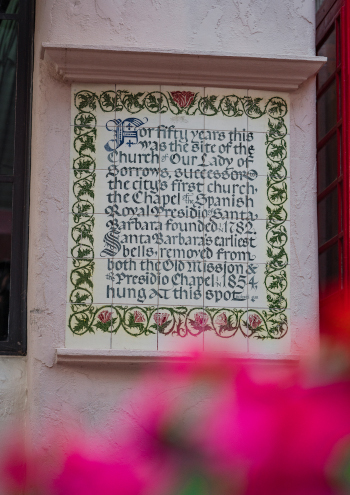
Hugh and Marjorie Petersen purchased the La Arcada Plaza in 1972. It was somewhat in disrepair and they turned it into the charming and beautiful plaza it is today with sculptures, fountains, and interactive public art brought from all over the world for all to enjoy. Although the Petersen’s are deceased, the property continues to be held and managed by the Petersen Family Trust.
The Clock on State Street was designed by Lawrence Schneider, former head clock smith at Tiffany’s. It was cast in Mexico and modeled after an historic landmark clock that has hung on the corner in Chicago by Marshall Field & Co. since 1880. See if you can find THE CLOCK:

The three La Arcada Plaza entryway signs are located on State Street, Figueroa Street, and the passage leading to the Santa Barbara Museum of Art and Library plaza. They were fashioned by Historical Arts & Casting of Utah, considered the finest metalwork shop in America. The lion/castle motif was taken from original frescoes on the building dating back to 1927. See if you can find all 3 ENTRYWAY SIGNS:
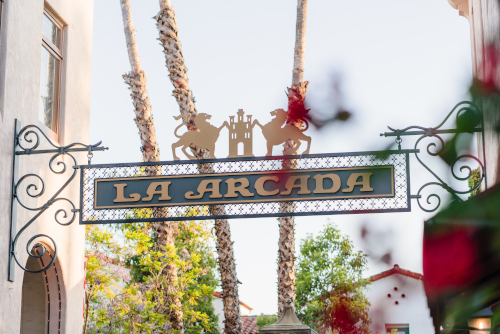
Children and the young at heart delight in the popular anchor of La Arcada Plaza, the turtle fountain. Locals and visitors to Santa Barbara enjoy dining by the fountain and at our six indoor and outdoor patio restaurants. Red Ear Slider turtles enjoy the rocks in the fountain. AMELIA, the flying turtle was named after Amelia Earhart, the first female aviator to fly solo across the Atlantic Ocean. She is the work of the late James “Bud” Bottoms, the sculptor Laureate of Santa Barbara. See if you can find THE TURTLE FOUNTAIN and AMELIA:


The full-size BRONZE DOLPHINS were designed for children to climb on by Bud Bottoms. His work here also includes the SEA LION fountain, the gleeful DOLPHIN HEAD spouting water at an unamused SEA TURTLE in mid breaststroke. The BRONZE WHALE TAIL BENCH is another of Bud Bottoms’ creations in solid bronze. There are INDIGENOUS ANIMALS OF THE CHANNEL ISLANDS hidden in the planter at State and Figueroa Street sculpted by Bud Bottoms. See if you can find all the BUD BOTTOM’S SCULPTURES:

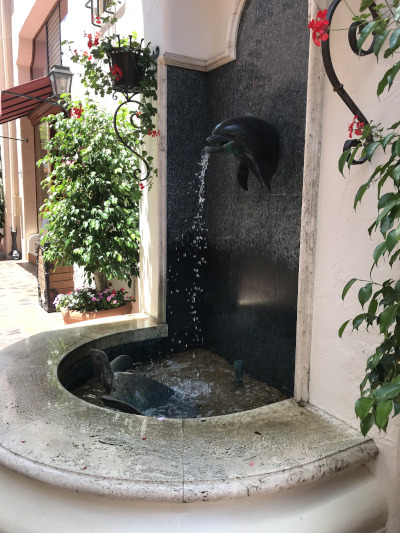
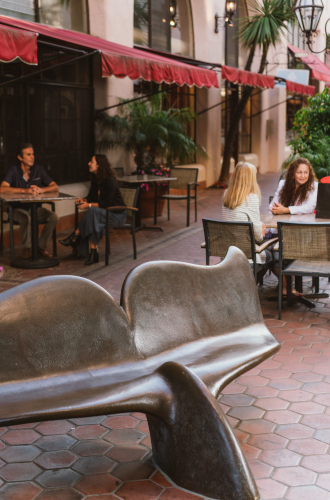
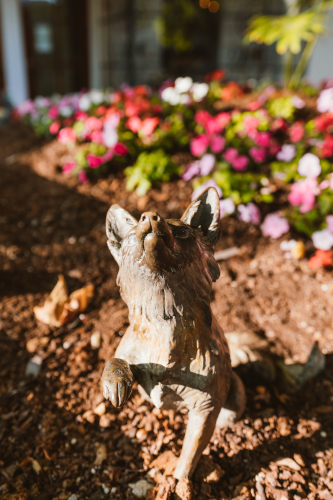
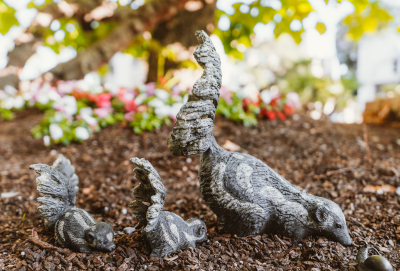
A 1761 mission bell was purchased from a Christie’s London auction in 1993 by Hugh Petersen. The rare Zacatecas bell was originally acquired by an Englishman in Baja, California. See if you can find the very early MISSION BELL:
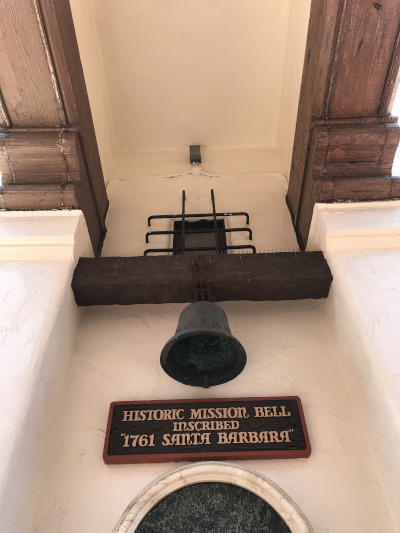
The Barber Shop in La Arcada Plaza is a working establishment and a mini-museum of the decorative arts that embellished the hair cutting parlors of the early 1900’s. The barber chairs were built by E.J. Kochs of Chicago around 1890. The barber poles are meticulously restored to their original working condition and the child’s barber chair fashioned from a carousel horse. They were also built around 1890. The STOVE is dated 1905. The SCALE no longer offers weight for a penny. See if you can find the BARBER CHAIRS and POLES:

A surprising addition to the collection in La Arcada Plaza is a bronze cannon from a Spanish galleon dated 1741. See if you can find the SHIP CANNON:

The sculpture of Ben Franklin, one of the Founding Fathers of the United States, was created by George Lundeen. See if you can find BEN FRANKLIN and see what he is reading:

The interactive sculpture by Bonifatius Stirnberg from Germany is called Mozart Trio Fountain. This was the first of his work to be seen in America. See if you can find the MOZART TRIO FOUNTAIN and imagine the music they might play:
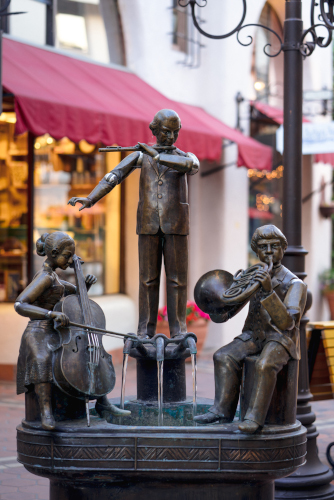
There is a lacquered steel sculpture facing the courtyard shared by the Santa Barbara Museum of Art and the Santa Barbara Public Library. It is titled Intermezzo (1967) by British artist, Sir Anthony Caro, one of Britain’s greatest sculptors, and was installed in 1988. See if you can find INTERMEZZO:
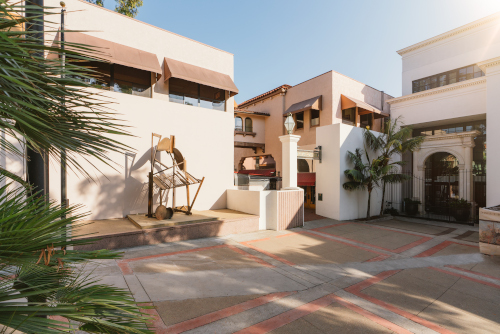
The Red Lacquered Phone Booth is as British as Big Ben and double decker busses. See if you can find the RED PHONE BOOTH:
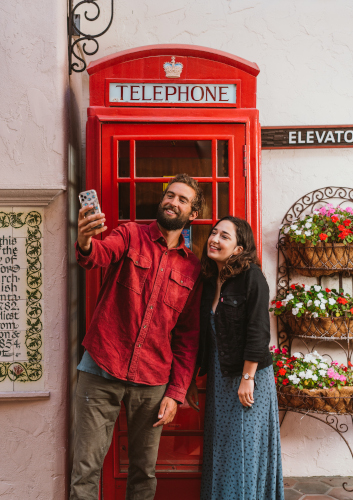
There are three sculptures by J. Seward Johnson, Jr. (1930-2020) in La Arcada Plaza. His trompe l’oeil painted bronze statues can be found all over the world. He made a reputation as a sculptor of the common man in life size. “NICE TO SEE YOU” depicts a window washer familiarly known as “Bob”. There is a book tucked into his back pocket for lunchtime reading. See what it is. “WHO’S IN CHARGE” is an exuberant father and son sharing quality time. The “CAROUSEL MURAL” by Donn Byrne provides a background for the Johnson figures. The carousel animal images were taken from famous woodcarvings of the “golden age” of merry-go-rounds and whirligigs which ended at the start of World War ll. The third J. Seward Johnson, Jr’s sculpture is “THE GENERATION BRIDGE.” The child’s doll lies on the bench momentarily forgotten as a grandfather shares his chocolate bar. See if you can find all THREE SCULPTURES AND THE MURAL:
